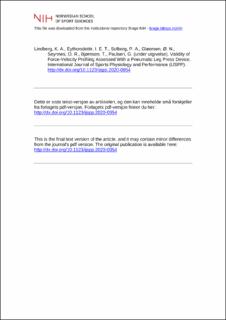| dc.contributor.author | Lindberg, Kolbjørn Andreas | |
| dc.contributor.author | Eythorsdottir, Ingrid Eir Thorp | |
| dc.contributor.author | Solberg, Paul André | |
| dc.contributor.author | Gløersen, Øyvind Nøstdahl | |
| dc.contributor.author | Seynnes, Olivier R. | |
| dc.contributor.author | Bjørnsen, Thomas | |
| dc.contributor.author | Paulsen, Gøran | |
| dc.date.accessioned | 2021-11-23T08:27:07Z | |
| dc.date.available | 2021-11-23T08:27:07Z | |
| dc.date.created | 2021-06-06T11:39:35Z | |
| dc.date.issued | 2021 | |
| dc.identifier.citation | International Journal of Sports Physiology and Performance (IJSPP). 2021, under utgivelse. | en_US |
| dc.identifier.issn | 1555-0265 | |
| dc.identifier.uri | https://hdl.handle.net/11250/2830877 | |
| dc.description | Dette er siste tekst-versjon av artikkelen, og den kan inneholde små forskjeller fra forlagets pdf-versjon. Forlagets pdf-versjon finner du her: https://doi.org/10.1123/ijspp.2020-0954 / This is the final text version of the article, and it may contain minor differences from the journal's pdf version. The original publication is available here: https://doi.org/10.1123/ijspp.2020-0954 | en_US |
| dc.description.abstract | Purpose: The aim of this study was to examine the concurrent validity of force–velocity (FV) variables assessed across 5 Keiser leg press devices. Methods: A linear encoder and 2 independent force plates (MuscleLab devices) were mounted on each of the 5 leg press devices. A total of 997 leg press executions, covering a wide range of forces and velocities, were performed by 14 participants (29 [7] y, 181 [5] cm, 82 [8] kg) across the 5 devices. Average and peak force, velocity, and power values were collected simultaneously from the Keiser and MuscleLab devices for each repetition. Individual FV profiles were fitted to each participant from peak and average force and velocity measurements. Theoretical maximal force, velocity, and power were deduced from the FV relationship. Results: Average and peak force and velocity had a coefficient of variation of 1.5% to 8.6%, near-perfect correlations (.994–.999), and a systematic bias of 0.7% to 7.1% when compared with reference measurements. Average and peak power showed larger coefficient of variations (11.6% and 17.2%), despite excellent correlations (.977 and .952), and trivial to small biases (3.9% and 8.4%). Extrapolated FV variables showed near-perfect correlations (.983–.997) with trivial to small biases (1.4%–11.2%) and a coefficient of variation of 1.4% to 5.9%. Conclusions: The Keiser leg press device can obtain valid measurements over a wide range of forces and velocities across different devices. To accurately measure power, theoretical maximal power calculated from the FV profile is recommended over average and peak power values from single repetitions, due to the lower random error observed for theoretical maximal power. | en_US |
| dc.language.iso | eng | en_US |
| dc.subject | strength testing | en_US |
| dc.subject | athlete assessment | en_US |
| dc.subject | force plate | en_US |
| dc.subject | linear encoder | en_US |
| dc.title | Validity of Force-Velocity Profiling Assessed With a Pneumatic Leg Press Device | en_US |
| dc.type | Peer reviewed | en_US |
| dc.type | Journal article | en_US |
| dc.description.version | acceptedVersion | en_US |
| dc.source.pagenumber | 9 | en_US |
| dc.source.journal | International Journal of Sports Physiology and Performance (IJSPP) | en_US |
| dc.identifier.doi | 10.1123/ijspp.2020-0954 | |
| dc.identifier.cristin | 1913937 | |
| dc.description.localcode | Institutt for fysisk prestasjonsevne / Department of Physical Performance | en_US |
| cristin.ispublished | true | |
| cristin.fulltext | postprint | |
| cristin.qualitycode | 1 | |
